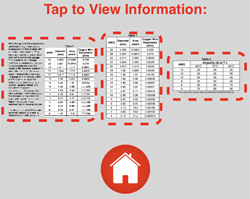About Wire Gauge
 Highly Recommended
Highly Recommended
Like all our Science Reasoning Center activities, the completion of the Wire Gauge activity requires that a student use provided information about a phenomenon, experiment, or data presentation to answer questions. This information is accessible by tapping on the small thumbnails found on the bottom right of every question. However, it may be considerably easier to have a printed copy of this information or to display the information in a separate browser window. You can access this information from
this page.
The Standards
The Wire Gauge activity describes the American Wire Gauge system (AWG) for expressing the width of electrical wires. Two tables are used to describe the relationship between wire gauge, wire diameter, cross-sectional area, resistance, and ampacity at specific temperatures. Questions target a student's ability to select data from a table, to identify the manner in which one variable depends upon another, to interpolate and to extrapolate from data within a table, to recognize complex numerical patterns in tables of data, and to combine information from two different tables to draw complex conclusions.
Success with the activity requires some degree of proficiency with respect to ...
- Developing and Using Models (Science and Engineering Practice 2.3)
Develop, revise, and/or use a model based on evidence to illustrate and/or predict the relationships between systems or between components of a system.
- Analyzing and Interpreting Data (Science and Engineering Practice 4.1)
Analyze data using tools, technologies, and/or models (e.g., computational, mathematical) in order to make valid and reliable scientific claims or determine an optimal design solution.
- Cause and Effect (Crosscutting Concept 1.2)
Empirical evidence is needed to identify patterns.
While the Wire Gauge activity addresses the two NextGen Science and Engineering Practices and the single crosscutting concept above, the activity drew its greatest inspiration from
ACT's College Readiness Standards for Science Reasoning. The activity consists of 56 questions organized into 17 Question Groups that are spread across the four activities. Two of the three strands (Interpretation of Data - IOD; and Experimental Results - EMI) of the College Readiness Standards are addressed in this activity. The code given for the standard includes three letters to indicate the strand and three numbers to indicate the specific standard within that strand. Higher numbers are indicative of more complex science reasoning skills. The relationship between the questions and the standards is as follows:
Complementary and Similar Resources
The following resources at The Physics Classroom website complement the Wire Gauge Science Reasoning Activity. Teachers may find them useful for supporting students and/or as components of lesson plans and unit plans.
Physics Classroom Tutorial, Electric Circuits Chapter: Electrical Resistance
Physics Video Tutorial, Electric Circuits: Electrical Resistance
Concept Builders, Electric Circuits: Current
Concept Builders, Electric Circuits: Resistance Ranking Tasks
Minds On Physics, Electric Circuits Module, Mission EC4: Resistance, Voltage, and Current
The Calculator Pad, Electric Circuits, Problem Set EC2